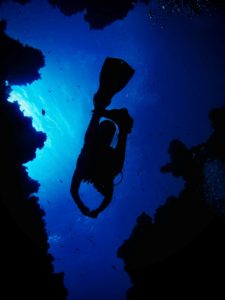 Since I can’t resist a good pun, I used this phrase as a chapter title in Submerged Hopes for a character with the bends, but though it’s come to mean “angry,” the idiom originally meant intoxicated or “bent” in 1833. Today, let’s talk about “the bends,” or decompression illness (DCI).
Since I can’t resist a good pun, I used this phrase as a chapter title in Submerged Hopes for a character with the bends, but though it’s come to mean “angry,” the idiom originally meant intoxicated or “bent” in 1833. Today, let’s talk about “the bends,” or decompression illness (DCI).
Decompression illness can occur during recreational or commercial diving, ascent from deep mines, at altitude in unpressurized aircraft, and during extravehicular activities in space. It’s also known as Caisson Disease, and was first noted in bridge workers constructing the Eads Bridge in St. Louis, the Brooklyn Bridge, and the Hudson River Tunnel. A caisson is a deep shaft, pressurized to keep water out, used during prolonged underwater work, like building bridges and dams. Recognition that caisson workers were dying ultimately led to the first medical airlock in 1889. It’s suspected that the affliction called taravana, seen in South Pacific pearl divers who may do as many as sixty dives a day with a short surface interval, is a form of DCI.
The early syndrome was called the “bends” if it involved the joints, since pain in the shoulders, knees, elbows, and ankles made the sufferer flex to attempt to relieve the pressure, “chokes” if they exhibited pulmonary symptoms of chest pain, dry cough, and shortness of breath, and “staggers” for neurologic symptoms of weakness or paralysis. Decompression illness is now classified into Type I (no neurologic symptoms) and Type II. Though the treatment is the same, the distinction has implications for recovery and return to eventual diving.
DCI occurs because at pressure, gas dissolves in the bloodstream and permeates the tissues. This is mainly nitrogen if breathing air. Though other gases do this, too, the exchange is faster for some. Thus, helium is sometimes used in dive mixtures (HeliOx). If the pressure relents slowly enough that the gas can be breathed out by the lungs, no injury occurs. However, if there is an abrupt change in pressure, the dissolved gas can suddenly come out of solution, much like when a soda bottle is opened. This forms bubbles in tissues and the bloodstream. The symptoms depend on the location of the bubbles, but the tendency to occur on a solid surface, or tribonucleation, accounts for not only the bubbles on the stems of flowers in a vase, but the frequency of joint symptoms in the bends.
Joint symptoms happen in 70% of cases, and can be excruciating. The physical disruption of cartilage, and the blockage of tiny blood vessels, can lead to eventual joint replacement for dysbaric osteonecrosis. Skin symptoms include itching, mottling, swelling, and formication, the sensation that bugs are crawling over one’s skin. Neurologic symptoms occur in 15% and manifest as numbness, tingling, heightened sensitivity, confusion, amnesia, visual abnormalities, loss of consciousness, and seizures. General symptoms are fatigue and aching. Most symptoms occur within the first eight hours, but a small percentage may take up to forty-eight hours to manifest.
Emergency treatment involves oxygen and fluids (to help dilute out the nitrogen) but the cornerstone is re-compression in a dive chamber or hyperbaric chamber. Early treatment gives an excellent chance of recovery, but the best plan is simple prevention. Fliers use pressurized aircraft or supplemental oxygen. Scuba divers use dive tables or dive computers to make sure their bottom time does not exceed the time needed to “off-gas” the dissolved nitrogen or “de-fizz,” safety stops underwater to allow an extra buffer for gas exchange, plan dives to allow a surface interval to help with off-gassing, and ascend slowly. Divers also avoid diving for twenty-four hours before flying. Sadly, many insurance carriers in the U.S. don’t cover recompression chamber treatment, evading it as a “recreational, avoidable, high risk” activity, so it’s worth it for a new scuba diver to check this.
Barotrauma is a separate malady, related to physical damage of tissue planes because of pressure, though it can occur in conjunction with DCI. This can be pneumothorax from a ruptured lung, arterial embolism when a blown-out lung allows bigger bubbles into the bloodstream, or perforated eardrums. These can be prevented by slow ascents, care to equalize pressures, and avoidance of holding one’s breath.
Altitude sickness, or acute mountain sickness, is an unrelated affliction, caused not by the rapid accumulation of microbubbles, but rather low oxygen related to low pressure as well as alkalosis, a shift in blood pH.
I find this fascinating but my hope is certainly not to deter any would-be scuba divers, and that maybe the descriptions in Submerged Hopes will encourage it. Should you try scuba diving? I’d say, go for it!
Recent Comments